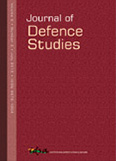India’s National Security: Annual Review 2018
National security refers to securing a nation’s citizens, territory, resources, assets, ideologies, institutions, and interests against threats which may emanate from changing geopolitical state of affairs, changing relations between nations, groups, races, sects, advancing technology and changing ideology. In the prevailing complex geopolitical scenario, India’s national security is facing new challenges and acquiring new dimensions with every passing year.
- Atul Pant |
- January-March 2019 |
- Journal of Defence Studies





